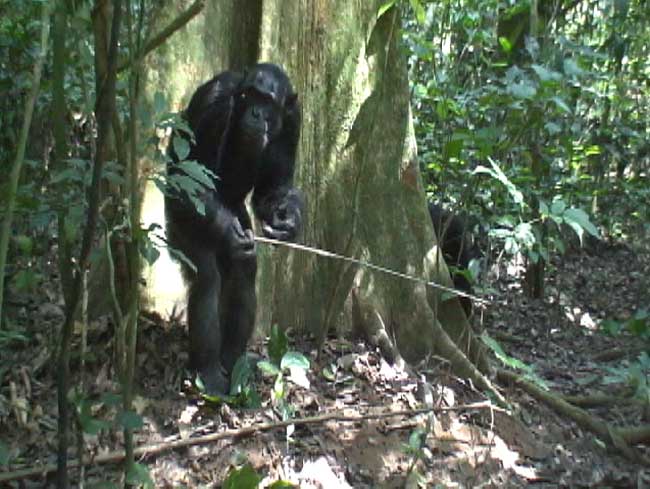Human Evolution: The Origin of Tool Use

Editor's Note: This is Part 8 in a 10-part LiveScience series on the origin, evolution and future of the human species and the mysteries that remain to be solved.
The way humans make and use tools is perhaps what sets our species apart more than anything else. Now scientists are more and more uncovering the forces that drove our lineage to our heights of tool use — and how tool use, in turn, might have influenced our evolution.
The first stone tools — the Oldowan
The ability to make and use tools dates back millions of years in our family tree. Chimpanzees, our closest living relatives, can on their own devise spear-like weapons for hunting and create specialized tool kits for foraging ants, suggesting our family tree may have possessed wooden tools since the ancestors of humans and chimps diverged some 4 million years ago.
The dawn of stone tools dates back some 2.6 million years to Gona in Ethiopia. Known as the Oldowan, these include not just fist-sized hunks of rock for pounding, but also the first known manufacture of stone tools — sharp flakes created by knapping, or striking a hard stone against quartz, obsidian, flint or any other rock whose flakes can hold an edge. At this time are also the oldest known butchered animal bones.
"So the hominids at this time, based on all the evidence that we have, had small australopithecine-sized brains, but nevertheless they figured out how to cut through often tough hide to efficiently get the meat off the bones and break the bones open for the marrow," said paleoanthropologist Henry Bunn at the University of Wisconsin at Madison.
Get the world’s most fascinating discoveries delivered straight to your inbox.
This was the extent of the technology for nearly a million years. "It was probably very ad hoc — when you needed a stone tool and you didn't have one, just made one, then dropped it," said paleoanthropologist Thomas Wynn at University of Colorado at Colorado Springs.
Such technology is just slightly past the range of what apes generally do, Wynn added. Indeed, chimpanzees in the wild can use stones as simple tools for hammering, and the chimpanzee-like bonobo ape can even be taught how to flake stone to make cutting tools. "These don't seem to represent any great intellectual leap," he said.
The appearance of stone tools falls roughly in the middle of a drying trend in Africa between 2 million and 3 million years ago that would have presented our distant ancestors with a greater variety of habitats than they would have known before, such as woodlands to grasslands, explained paleoanthropologist Thomas Plummer at Queens College in New York. "Tools may have allowed hominids to be more adaptable, extract food from a greater range of areas," he said.
A great advance in technology — the Acheulean
Jump ahead to roughly 1.8 million years ago and both technology and our lineage have changed.
"You now have rough hand axes and cleavers," Wynn said. "The technology is really different, more sophisticated in a cognitive way than anything earlier hominids or chimpanzees could do — some see cognitive abilities to coordinate spatial and shape information that chimpanzees don't have. This is the beginning of what we call the Acheulean."
At about that time, Homo erectus has emerged. "Finally all the adaptations for arboreal life have gone," Wynn said. "Erectus has gone completely terrestrial — not climbing trees very much at all."
In addition, "Homo erectus has started carrying tools around, instead of dropping them after use," Wynn said. "Technology has become part of their adaptive niche, a more or less permanent day-to-day thing relied on regularly. It's all tremendously significant from a cognitive point of view. I would place all this as an even more significant transition than the initial use of stone tools."
Meat and evolution
Homo erectus evolved in ways "to make getting access to meat and efficiently digesting meat more successful — you've got increased brain size, about two-thirds that of the modern human average, and increased body size," Bunn said. "You've also got a reduction in gut size, so you can devote the resources that would normally go there toward a bigger brain, as well as this high-energy brain food of meat to support those large brains."
This doesn't mean that early stone tools were restricted to just processing animal carcasses, Bunn noted, "or that meat became a dominant factor in their lives, since by all indications, from chimpanzees to tropical hunter-gatherer people today, plants are the dominant day-to-day part of the diet. It just shows an increased interest in meat."
Technology and society
As tool use evolved, "somewhere along the line, there had to have been really important changes in social evolution," Wynn said.
Scientists argue, for instance, when provisioning or the sharing of food began. "In Homo erectus, you see an increase in female size, which some argue suggests that infants are born less mature, thus requiring more maternal care. So the suggestion is that provisioning helps females find something to eat."
There are two ideas regarding provisioning. One is that males are the ones bringing food over due to pair-bonding between the sexes. Another is the "grandmother hypothesis," where grandmothers bring their daughters food to help them raise their offspring. "The problem with that is that with all male African apes, females leave groups at adolescence, so the grandmother hypothesis would represent a pretty dramatic change socially," Wynn said.
Still, Wynn noted other research has suggested primates spread throughout the Old World do possess these female links, "and Homo erectus has a very different distribution from the African apes, were distributed more widely in Africa and Asia, and so maybe Homo erectus mimics the behavior of these other primates. Also, the new fossil Ardipithecus tells us our ancestors may not have been very much like chimps and gorillas, so maybe socially we were not as alike as well."
Windows into the brain
Now scientists are using stone tools as windows to help investigate how the brains of the human family tree evolved over time.
"What was it these early stone-knappers knew that chimpanzees can't get?" Wynn asked. "I think one thing was that early hominids were much better at copying motor procedures — we can watch an individual perform a motor task and mimic it. Chimpanzees are terrible at that — they see a task and have to reinvent the wheel. This gets back to mirror neurons and the copying of behavior."
"Tools are the products of our brains, and we have millions of stone tools," Wynn added. What we need are more creative ideas on how to extract understanding from them, and what they tell us about our evolution."
- Top 10 Mysteries of the First Humans
- Poll: Your View of Human Evolution
- Top 10 Things That Make Humans Special



